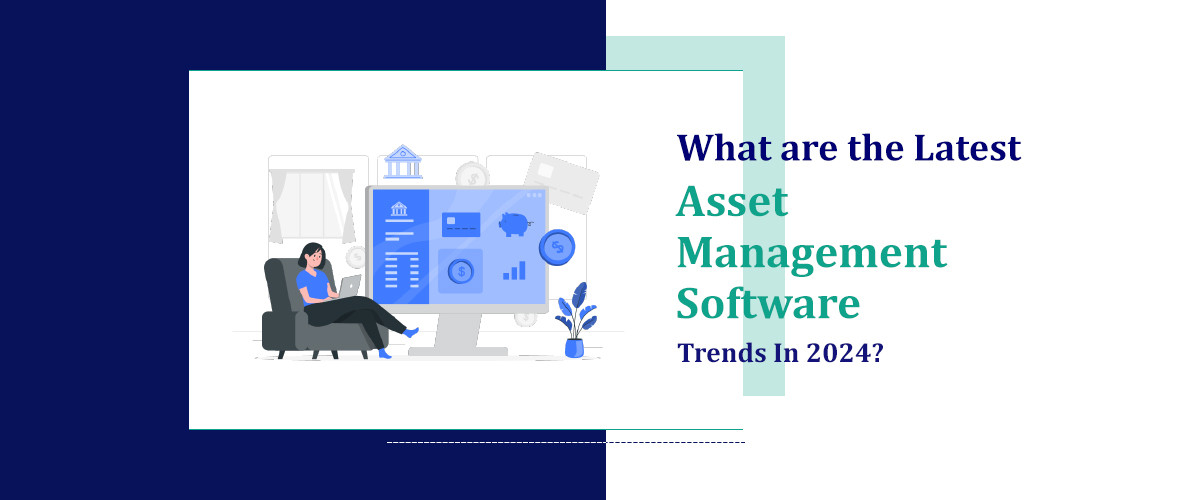What we'll cover
The fast-paced digital environment of today has made asset management more difficult. Asset managers are using digital solutions that offer efficiency, accuracy, and strategic insights to help them traverse this complexity. The Asset management software industry is always changing, adjusting to new developments and trends. We will examine the most recent developments in asset management software that will influence the market in 2024 in this blog article. This piece will offer insightful information on the direction asset management is taking, regardless of your background as a software developer, asset manager, or enthusiast.
Introduction
Asset management software plays a vital role in effectively managing and optimizing assets. It streamlines processes, improves decision-making, and enhances risk management. As technology continues to advance at a rapid pace, asset management software must keep up with new trends and capabilities to stay relevant. Let's delve into the latest trends that will shape the future of asset management software in 2024.
How Asset Management Software Works?
(AMS) is essential to U.S. platforms because it makes monitoring, controlling, and organising corporate assets easier. Businesses in the US are able to trace their assets from acquisition to disposal because to the Asset Management System (AMS). Along with information like maintenance schedules and depreciation values, the programme offers real-time updates on the state and location of the assets. Another essential component of AMS is compliance with US financial and auditing requirements, which guarantees that companies are following relevant laws and guidelines. Businesses in the US can benefit from AMS by becoming more efficient, spending less money, and making better asset management decisions.
For American firms, asset management software (AMS) is an essential tool. It makes monitoring, managing, and organising business assets easier. Without the right software, this may be a difficult operation. Businesses can decide wisely regarding their assets thanks to the AMS's real-time information on asset location and status. However, just what assets does AMS assist in managing?
Assets can mean different things to different types of businesses, but generally speaking, they mean any useful resource that a firm owns. This can apply to financial assets like stocks and bonds, as well as intellectual property like patents and trademarks, as well as tangible assets like machinery and equipment.
Effective asset management is essential for U.S. firms to succeed and expand. Businesses can efficiently Asset tracking software and manage an asset's full lifecycle from acquisition to disposal with the help of AMS. This guarantees adherence to financial and auditing laws in addition to promoting efficiency and organisation.
Asset managers in blockchain and decentralized finance must choose a reliable RPC node provider to ensure secure and efficient blockchain access For asset managers in blockchain and decentralized finance, selecting a reliable RPC node provider is crucial to ensuring secure and efficient blockchain access.
Key functionalities embody asset tracking, which statistics asset vicinity, usage, and maintenance schedules. It often uses barcodes, RFID tags, or QR codes to efficiently music assets. The software program can also manipulate asset lifecycles, making sure well timed maintenance, upgrades, or replacements, thereby decreasing downtime and prolonging asset lifespan. Financial manage functions help in calculating depreciation, handling warranties, and planning budgets. Users can get proper of access to real-time information and generate reports, permitting knowledgeable choice-making concerning asset allocation, usage, and disposal.
Many answers also offer integration with different commercial organization systems like ERP or accounting software, enhancing everyday operational efficiency. By automating these strategies, Asset Management Software reduces the hazard of asset loss, minimizes administrative overhead, and optimizes the usage of sources. This is in particular precious in industries like IT, production, healthcare, and production, in which effective asset manage is essential for preserving operational continuity and controlling charges.
Challenges of Asset Management Software
The US market for asset management software confronts a number of difficulties. First off, it can be difficult and time-consuming to integrate current organisational data into a new system, which increases the risk of data loss or corruption. Second, organisations may experience problems with system compatibility when software is upgraded or changed. Furthermore, it might be challenging to make sure the software complies with strict regulatory compliance standards, particularly in industries like healthcare and banking. Finally, with the speed at which technology is developing, it might be difficult to maintain software updates and teach employees on how to use it efficiently.
For American firms, asset management software is an essential tool for effectively tracking and managing their assets. On the other hand, maintaining and implementing such software might be difficult.
Integrating current data into a new system is a frequent problem that organisations encounter. If not managed appropriately, this procedure can be difficult and time-consuming, frequently leading to data loss or corruption. In order to guarantee a seamless transition, businesses may need to devote a large amount of time and money to this effort.
Additionally, since technology develops at a quick pace, companies may have difficulties with system compatibility. When businesses have previously invested in a particular piece of software that is no longer maintained or compatible with updates or other solutions, this may be very troublesome.
Leading the 2024 Asset Management Software Trends
-
Trend 1: Artificial Intelligence and Machine Learning
In asset management software, artificial intelligence (AI) and machine learning (ML) have become revolutionary. These technologies allow for large-scale data analysis, pattern recognition, and data-driven decision making. by learning AI from scratch may concentrate on higher-value duties by using AI and ML to automate repetitive operations like data input and reconciliation.
Additionally, with real-time risk identification and anomaly detection, AI-powered algorithms may improve risk management.
-
Trend 2: Cloud-Based Solutions
Many advantages come with cloud-based asset management systems, such as cost-effectiveness, scalability, and accessibility. Asset managers are able to effortlessly grow their operations as needed, interact with ease, and access vital information from any location. Additionally, automated software upgrades and lower infrastructure expenses are two benefits of cloud-based systems that guarantee asset managers have access to the newest features and security improvements. Nonetheless, asset managers should carefully assess the security measures put in place by their selected cloud service provider because data protection is still of utmost importance. Also, understanding the distinctions between slo vs sla can further help asset managers ensure they are choosing the right provider.
-
Trend 3: Blockchain Technology
Asset management is just one of the areas that blockchain technology is revolutionising. Asset managers may increase operational efficiency, security, and transparency by utilising blockchain. Blockchain makes it possible to create an unchangeable ledger that documents each transaction, guaranteeing an open, verifiable history and trail of asset ownership. Furthermore, asset transfers may be automated by blockchain-based smart contracts, eliminating the need for middlemen and simplifying the procedure as a whole.
-
Trend 4: Robotic Process Automation (RPA)
In asset management, robotic process automation, or RPA, is revolutionising back-office activities. With the help of RPA, asset managers may automate repetitive and rule-based processes, giving them more time to concentrate on strategic duties. Asset managers may minimise mistakes, save operating costs, and earn considerable efficiency improvements by integrating RPA with current systems. Numerous operations, including as data input, reporting, and compliance checks, can benefit from the use of RPA.
-
Trend 5: Mobile Applications
The need for mobile applications in asset management is growing as asset managers become more mobile. Mobile applications make asset managers more accessible and convenient by enabling them to track performance, keep an eye on portfolios, and communicate with team members in real time. Asset managers can stay connected and make fast decisions while on the road with the help of mobile applications, which can increase productivity.
The Future of Asset Management Software
Asset management software is expected to have a very bright future in the US market, with a strong preference for automation, predictive analytics, and artificial intelligence. Businesses will be able to manage their assets more effectively, save operating expenses, and increase overall productivity thanks to these developments. Real-time asset tracking and monitoring will be greatly improved with the integration of IoT technology, allowing for more precise and rapid decision-making. Furthermore, the trend towards cloud-based solutions is probably going to continue, giving companies more scalability and flexibility. In the post-pandemic age, when Digital asset management software transformation and remote access are becoming more and more crucial, this change will prove to be crucial.
Many organisations have already adopted these innovations, making the US platform an industry leader in asset management software. Still, there's space for advancement and creativity in this industry. Asset management software will advance in sophistication and business value as technology develops and advances.
The use of artificial intelligence (AI) in asset management is one subject that is subject to fast development. Businesses could make information-pushed alternatives for their assets way to AI technology's capacity to analyze extensive volumes of statistics and bring insightful evaluation. This can help uncover feasible dangers and regions for price-saving answers and growing efficiency.
Understanding Service Level Objectives (SLOs) and Service Level Agreements (SLAs) may play a critical post role in context. While SLAs outline the expected carrier requirements among providers and patrons, SLOs are extra precise metrics inside SLAs that define the target overall performance degrees. By leveraging AI, businesses can better reveal and meet those slo vs sla, ensuring the most effective asset management and more advantageous provider transport.
How to Choose the Right Software Asset Management Software
Selecting the best asset management software necessitates carefully weighing several aspects. Determine your unique asset management needs and objectives first and foremost. This might involve managing digital resources or keeping track of tangible assets. Second, think about how scalable the software is.
Your asset management requirements may vary as your firm expands, and the software should be able to keep up with that development. Third, evaluate the usefulness of the programme. It ought to be simple to use and need little training for your staff. Fourth, consider the software's integration features. For optimal effectiveness, it should interact with your current systems with ease.
Finally, think about the price. A solution should satisfy all of your requirements and still be affordable.There are other considerations that you should make while assessing asset management software. One of these is the software company's degree of customer assistance. Make sure there is a committed crew on hand to help you in the event that you have any technical problems or issues.
The software's security features are another crucial factor to take into account. You want to be sure that the programme has robust security measures in place to safeguard your assets, which include sensitive and important data.
It's crucial to consider the software's reporting features as well. For the purpose of making well-informed decisions, managers and owners of businesses require access to precise and comprehensive reports on their assets.
Conclusion
As we look ahead to 2024, the asset management industry will continue to embrace technological advancements to gain a competitive edge. the Asset Management Software SaaS Adviser platform is a game-changer in the realm of managing digital assets. By streamlining operations and ensuring efficient allocation of resources, it promotes operational efficiency and productivity. As a listing platform, it provides a comprehensive overview of available software solutions, enabling users to make informed decisions that best fit their needs and budget. With the continued advancement of technology, we anticipate this platform to continually evolve, offering even more sophisticated functionalities and transforming how businesses manage their digital assets




